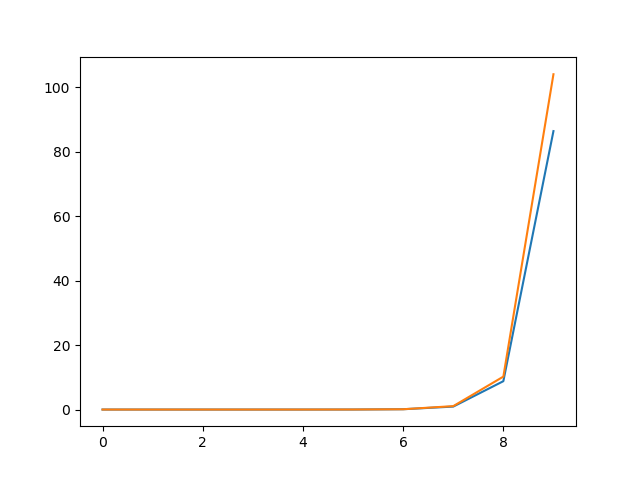Python類的動(dòng)態(tài)綁定實(shí)現(xiàn)原理
使用實(shí)例引用類的屬性時(shí),會(huì)發(fā)生動(dòng)態(tài)綁定。即python會(huì)在實(shí)例每次引用類屬性時(shí),將對(duì)應(yīng)的類屬性綁定到實(shí)例上。
動(dòng)態(tài)綁定的例子:
class A: def test1(self): print('hello') def test2(self): print('world')def bound(): a = A() a.test1() A.test1 = A.test2 a.test1()if __name__ == '__main__': bound()
輸出結(jié)果:
hello2 world
從上述代碼中可以看到,類方法的變化是實(shí)時(shí)影響實(shí)例對(duì)方法的調(diào)用的,這說(shuō)明python是在實(shí)例調(diào)用方法的過(guò)程中動(dòng)態(tài)地查找類方法。
動(dòng)態(tài)綁定的代價(jià):
class A: def test(self): passdef one_loop(limited_time): a = A() for i in range(limited_time): a.test() f = a.test for i in range(limited_time): f()
上圖兩個(gè)循環(huán)中,一個(gè)調(diào)用a.test(),不斷進(jìn)行動(dòng)態(tài)綁定,另一個(gè)則先把a(bǔ).test賦值給f,只有一次動(dòng)態(tài)綁定,通過(guò)對(duì)兩個(gè)循環(huán)計(jì)時(shí),測(cè)試動(dòng)態(tài)綁定的代價(jià)。
輸出結(jié)果:

1 [0.0, 0.0, 0.0, 0.0, 0.0, 0.0009999275207519531, 0.008995771408081055, 0.19991111755371094, 1.2715933322906494, 15.831915855407715]2 [0.0, 0.0, 0.0, 0.0, 0.0, 0.12503726671039295, 0.09472344399590288, 0.1999776288967874, 0.131608969147562, 0.1553209370384522]
折線圖中橫坐標(biāo)為log10(循環(huán)次數(shù)),縱坐標(biāo)為秒數(shù)。
輸出數(shù)據(jù)中,第一行為動(dòng)態(tài)綁定和一次綁定耗費(fèi)時(shí)間的差值,第二行為差值占動(dòng)態(tài)綁定總時(shí)間的比例。
可以看出,在次數(shù)很小的時(shí)候,兩者基本沒(méi)有差距,或者說(shuō)差距忽略不計(jì)。
在10^7次循環(huán),即千萬(wàn)次循環(huán)的時(shí)候,動(dòng)態(tài)綁定與靜態(tài)綁定的耗費(fèi)時(shí)間才出現(xiàn)了明顯差異,當(dāng)循環(huán)次數(shù)達(dá)到十億級(jí)的時(shí)候,耗費(fèi)時(shí)間相差15秒之多,約占總時(shí)間的15%。
由上可知,動(dòng)態(tài)綁定效率低于靜態(tài)綁定,但由于綁定代價(jià)耗時(shí)很少,在次數(shù)很少的時(shí)候基本沒(méi)有影響。
動(dòng)態(tài)綁定的優(yōu)點(diǎn):
class A: def test_hello(self): print('hello')def test_world(self): print('world')def main(): s = A() # 提前綁定 f = s.test_hello # 改變方法 A.test_hello = test_world f() # 動(dòng)態(tài)綁定 s.test_hello()if __name__ == '__main__': main()
輸出結(jié)果:
hello2 world
類方法的變動(dòng)能夠?qū)崟r(shí)反應(yīng)在動(dòng)態(tài)綁定上,而提前綁定則無(wú)法感知到類方法的變動(dòng)。
總結(jié):
1. 一次動(dòng)態(tài)綁定代價(jià)很小,當(dāng)綁定次數(shù)少的時(shí)候基本不影響效率,當(dāng)綁定次數(shù)達(dá)到千萬(wàn)級(jí)時(shí)影響才會(huì)很顯著。
2. 動(dòng)態(tài)綁定實(shí)時(shí)跟蹤類方法的變動(dòng),更具靈活性。
以上就是本文的全部?jī)?nèi)容,希望對(duì)大家的學(xué)習(xí)有所幫助,也希望大家多多支持好吧啦網(wǎng)。
相關(guān)文章:
1. 基于javaweb+jsp實(shí)現(xiàn)學(xué)生宿舍管理系統(tǒng)2. 如何封裝一個(gè)Ajax函數(shù)3. ASP.NET MVC實(shí)現(xiàn)樹(shù)形導(dǎo)航菜單4. 多級(jí)聯(lián)動(dòng)下拉選擇框,動(dòng)態(tài)獲取下一級(jí)5. jsp網(wǎng)頁(yè)實(shí)現(xiàn)貪吃蛇小游戲6. Ajax常用封裝庫(kù)——Axios的使用7. jsp+servlet簡(jiǎn)單實(shí)現(xiàn)上傳文件功能(保存目錄改進(jìn))8. CSS Hack大全-教你如何區(qū)分出IE6-IE10、FireFox、Chrome、Opera9. 怎樣打開(kāi)XML文件?xml文件如何打開(kāi)?10. Python數(shù)據(jù)分析JupyterNotebook3魔法命令詳解及示例

 網(wǎng)公網(wǎng)安備
網(wǎng)公網(wǎng)安備